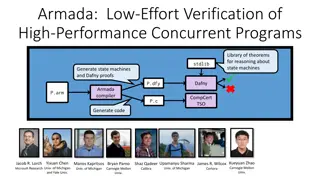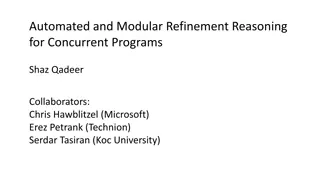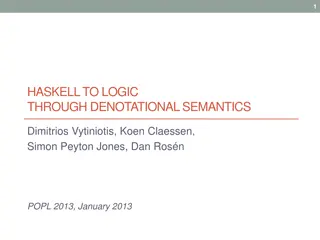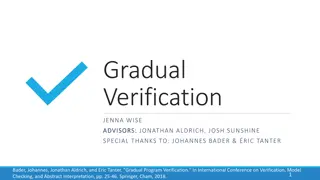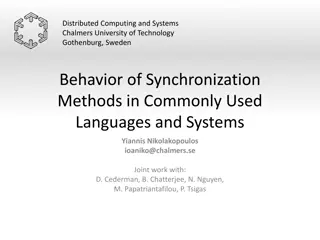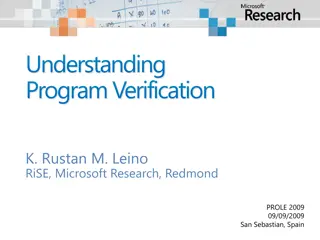Foundations of Concurrent Program Verification
Explore the importance of program verification methodologies, modular verification, and specification styles in ensuring the correctness of concurrent programs. Learn about key concepts like pre- and postconditions, loop invariants, and the role of specifications in bug detection and testing.
Download Presentation

Please find below an Image/Link to download the presentation.
The content on the website is provided AS IS for your information and personal use only. It may not be sold, licensed, or shared on other websites without obtaining consent from the author.If you encounter any issues during the download, it is possible that the publisher has removed the file from their server.
You are allowed to download the files provided on this website for personal or commercial use, subject to the condition that they are used lawfully. All files are the property of their respective owners.
The content on the website is provided AS IS for your information and personal use only. It may not be sold, licensed, or shared on other websites without obtaining consent from the author.
E N D
Presentation Transcript
A Foundation for Verifying Concurrent Programs K. Rustan M. Leino RiSE, Microsoft Research, Redmond joint work with Peter M ller and Jan Smans Lecture 0 1 September 2009 FOSAD 2009, Bertinoro, Italy
Program verification Prove program correctness for all possible inputs and behaviors
Modular verification Prove parts of a program separately Correctness of every part implies correctness of whole program
Specifications Record programmer design decisions Describe usage of program constructs Provide redundancy Enable modular verification
Specification style Specification and verification methodology Describes properties of the heap Active area of research Ownership Spec#, Java+JML, vcc, type systems, Dynamic frames VeriCool, Dafny Permissions (capabilities) Effect systems, separation logic, VeriCool 3, Chalice,
Concurrent programs Interleaving of thread executions Unbounded number of: threads, locks, We need some basis for doing the reasoning A way of thinking!
These lectures Concurrent programs Features like: threads, monitors, abstraction as well as: objects, methods, loops, Avoid errors like: race conditions, deadlocks Specifications with permissions Building a program verifier
Square Pre- and postconditions
Cube Loop invariants
ISqrt Chalice
Specifications at run time Helps testing find bugs more quickly Optional, they can be treated as ghosts If they are to be ghosted, specifications must have no side effects (on non-ghost state)
Dealing with memory (the heap) Access to a memory location requires permission Permissions are held by activation records Syntax for talking about permission to y: acc(y)
Inc Permissions
Transfer of permissions method Main() { var c := new Counter; call c.Inc(); } method Inc() requiresacc(y) ensuresacc(y) { y := y + 1; }
Well-formed specifications A specification expression can mention a memory location only if it also entails the permission to that location acc(y) && y < 100 y < 100 acc(x) && y < 100 acc(o.y) && p.y < 100 o == p && acc(o.y) && p.y < 100 x / y < 20 y 0 && x / y < 20
Loop invariants and permissions A loop iteration is like its own activation record Before; while (B) invariant J { S; } After; is like Before; call MyLoop( ); After; method MyLoop( ) requires J ensures J { if (B) { S; call MyLoop( ); } }
Loop invariant: example method M() requiresacc(x) && acc(y) && x <= 100 && y <= 100 { while (y < 100) invariantacc(y) && y <= 100 { y := y + 1; x := x + 1; // error: no permission to access x } assert x <= y; }
Loop invariant: example method M() requiresacc(x) && acc(y) && x <= 100 && y <= 100 { while (y < 100) invariantacc(y) && y <= 100 { y := y + 1; } assert x <= y; }
ISqrtwith fields Loop invariants with permissions
Threads Threads run concurrently A new thread of control is started with the fork statement A thread can wait for another to complete with the join statement Permissions are transferred to and from a thread via the starting method s pre- and postconditions
ForkInc Fork and join
The two halves of a call call == fork + join call x,y := o.M(E, F); is semantically like fork tk := o.M(E, F); join x,y := tk; but is implemented more efficiently
TwoSqrts Parallel computation
Well-formed revisited Recall: A specification expression can mention a memory location only if it also entails some permission to that location Example: acc(y) && y < 100 Without any permission to y, other threads may change y, and then y would not be stable
Read permissions acc(y) write permission to y rd(y) read permission to y At any one time, at most one thread can have write permission to a location
VideoRental Parallel reads
Fractional permissions acc(y) 100% permission to y acc(y, p) p% permission to y rd(y) read permission to y Write access requires 100% Read access requires >0% = +
Implicit dynamic frames method M() requires acc(y) ensures acc(y) can change y Can method P() requires rd(y) ensures rd(y) change y? That is, can we prove: method Q() requiresrd(y) && y == 5 { call P(); assert y == 5; } Demo: NoPerm
Shared state What if two threads want write access to the same location? methodA() { y := y + 21; } class Fib { var y: int; method Main() { var c := new Fib; fork c.A(); fork c.B(); } } ? methodB() { y := y + 34; }
Monitors methodA() { acquirethis; y := y + 21; releasethis; } class Fib { var y: int; invariantacc(y); method Main() { var c := new Fib; share c; fork c.A(); fork c.B(); } } methodB() { acquirethis; y := y + 34; releasethis; }
Monitor invariants Like other specifications, can hold both permissions and conditions Example: invariant acc(y) && 0 <= y
Object life cycle share thread local shared, available new release acquire shared, locked
SharedCounter Monitors
Locks and permissions The concepts holding a lock, and having permissions are orthogonal to one another In particular: Holding a lock does not imply any right to read or modify shared variables Their connection is: Acquiring a lock obtains some permissions Releasing a lock gives up some permissions
Thread-safe libraries Server-side locking safer (requires less thinking) invariant acc(y); method M() requirestrue { acquirethis; y := ; releasethis; } Client-side locking more efficient method M() requiresacc(y) { y := ; }







